Enhance your data security, governance, and resilience with the latest updates to the AvePoint Confidence Platform. This October, we bring you advanced features to further secure your data and operations, streamline workflows, and improve productivity. In today’s fast-paced digital landscape, robust and efficient data management solutions are crucial for maintaining a competitive edge and ensuring compliance. From expanded Azure SQL support in Cloud Backup to streamlined physical records management in AvePoint Opus and tyGraph benchmarking for Copilot adoption, explore all the new features and see how the AvePoint Confidence Platform can simplify, secure, and optimize your digital workplace.
Key Highlights:
Enhanced Security and Efficiency in Cloud Backup: New controls for Teams chat access, approval workflows and controls for zero-trust deletions in Salesforce Backup, expanded Azure SQL support (private preview), and multi-geo support for Google Workspace.
Elevated Content Management in AvePoint Opus: Enhanced physical records management, improved import/export processes, Korean language support, and Box integration (private preview).
Proactive Automation in EnPower: New Power Automate flows status column to address issues before they arise, smoother automated processes, enhanced troubleshooting, and more dynamic workflows.
Advanced Reporting and Benchmarking in tyGraph: Opt-in to benchmarking for secure, anonymous Copilot adoption comparison, new data centers in France and Singapore, and improved reporting filters for greater flexibility and insights.
Simplified Reporting and Migration in Fly: Global overview of migration projects, seamless migration of customized SharePoint Online forms/apps, and easy creation of Microsoft Teams for channel, user, and conversation migration.
Explore all the latest updates across the AvePoint Confidence Platform or jump to a specific product by clicking on any of the links below.
AvePoint Cloud Backup
What’s new in Cloud Backup for Microsoft 365?
Administrators can now regulate access to Teams chat messages in Microsoft 365, significantly enhancing data security and compliance. Enhanced manual deletion features now support folder-level deletions, allowing users to remove entire folders at once, which is especially useful for efficiently managing large volumes of files. A new approval workflow for content deletion ensures administrator oversight before any data is removed.
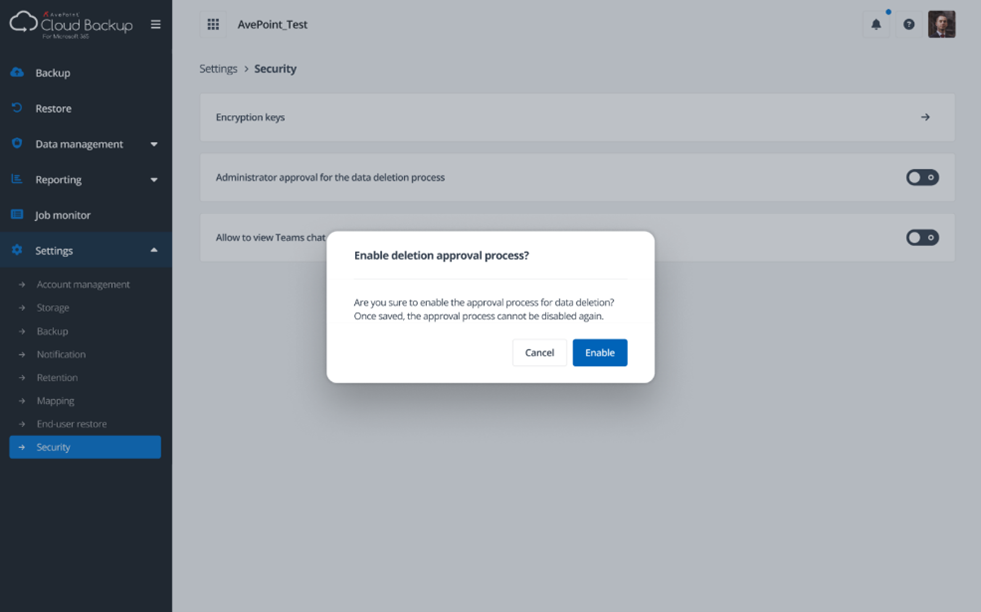
Additional updates include new calendar-style recovery points for Exchange Online, additional columns in the restore table, and a setting to restore all content backed up before a recovery point, including deleted items provide comprehensive data recovery options. Real-time monitoring for restore and export jobs is now available, along with an improved filter application for the job monitor and system auditor. The new email attachment filter makes it easy to search for and restore emails with attachments in Exchange Online. Cloud Backup Express updates ensure compliance with enterprise license policies by failing backups for new objects when out of policy, while continuing backups for existing objects for 90 days. Additionally, you can now restore deleted emails to a separate folder for easier access and organization.
What’s new in Cloud Backup for Salesforce?
Salesforce users can now generate a pre-restore report to preview the impact of a restore job, including data size, record count, and affected elements, without running it in production to ensure there’s no impact to the business.
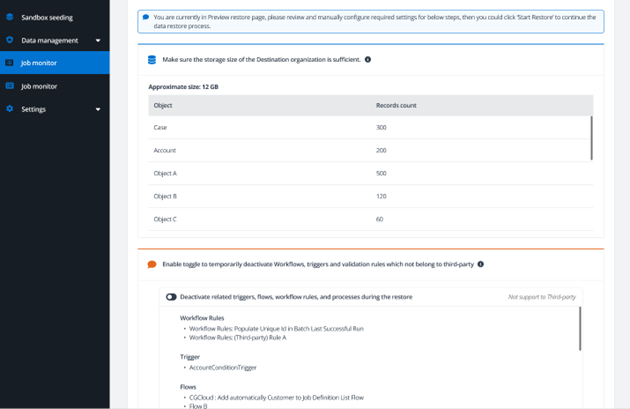
Specific parent or child records can be chosen for restoration, ensuring you have granular control over which records are restored. Search now supports field level queries, such as Email Address or User Name, to speed up and improve the accuracy of restores when Record IDs aren’t enough or known. Compare jobs can be run on Discover search results, and security profiles can be configured to limit access to specific objects, supporting Zero Trust security. Plus, data cleanup jobs now require a second administrator’s approval, preventing unauthorized deletions.
What’s new in Cloud Backup for Google Workspace?
Google Workspace admins can now use a calendar view to locate objects and perform batch restores for specific recovery points, streamlining the restore process and minimizing business disruption. Data center locations for Shared Drive data can be specified, supporting regulatory compliance and internal best practices.
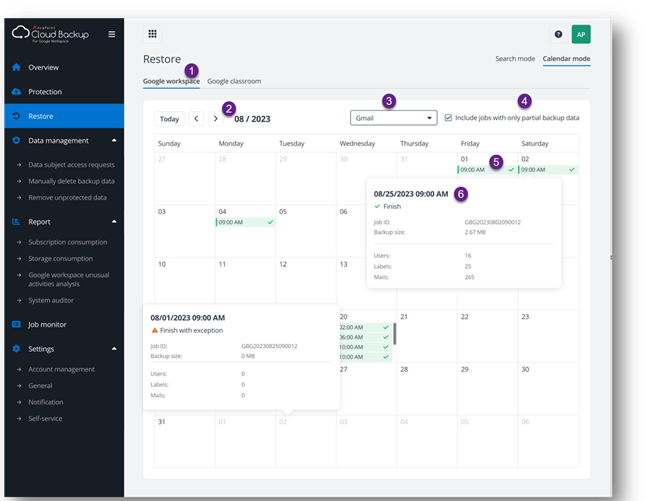
What’s new in Cloud Backup for IaaS + PaaS?
In this release, we are expanding our Azure SQL support to include full backup and restore capabilities, now available in private preview, enabling comprehensive protection for Azure SQL databases. Please contact your Account Executive if you are interested in joining the preview. A new panel in IaaS + PaaS ensures all necessary permissions are verified before saving or running a backup plan, enhancing security and preventing failed backups.
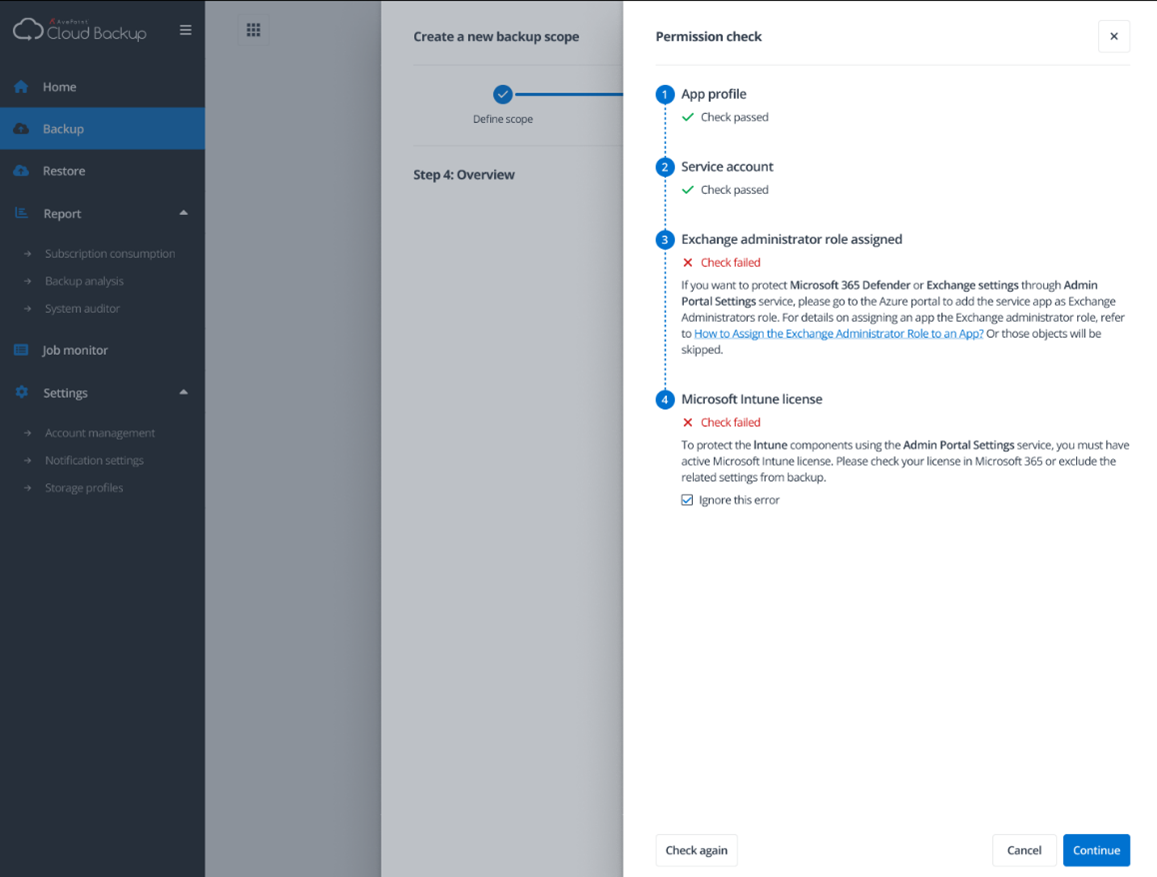
Backup scopes can now be defined with specific objects rather than the entire tenant, offering greater control and customization. Entra ID comparison reporting allows up to 100 specific objects to be selected for comparison during a restore job, improving efficiency by streamlining the process and enhancing accuracy by ensuring only relevant data is restored.
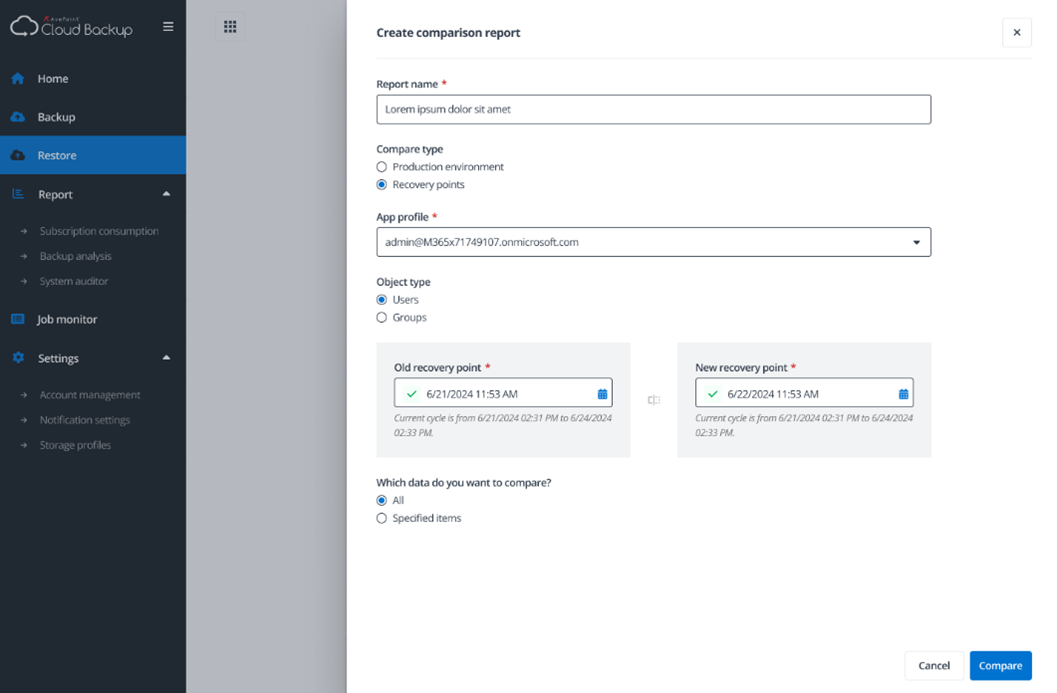
Support for out-of-place (OOP) restore for users and groups in Entra AD allows data restoration to a different tenant, ideal for organizations with multiple Azure tenants. Additionally, specific disks can now be selected for backup jobs, providing greater control and precision over the backup process.
AvePoint Cloud Governance
What's new in AvePoint Cloud Governance?
New Viva Engage profiles have been incorporated into the modern admin center, including profiles for storage management, renewal, deactivated contact election, and external sharing. These profiles can also be applied in the workspace report, providing a more streamlined and efficient management experience. Plus, sensitivity label confirmation is now part of the workspace renewal process for Teams, Microsoft 365 Groups, SharePoint sites, and Viva Engage communities. The selected label will automatically set the external sharing and privacy settings for the workspace, ensuring that your data remains secure and compliant with organizational policies.
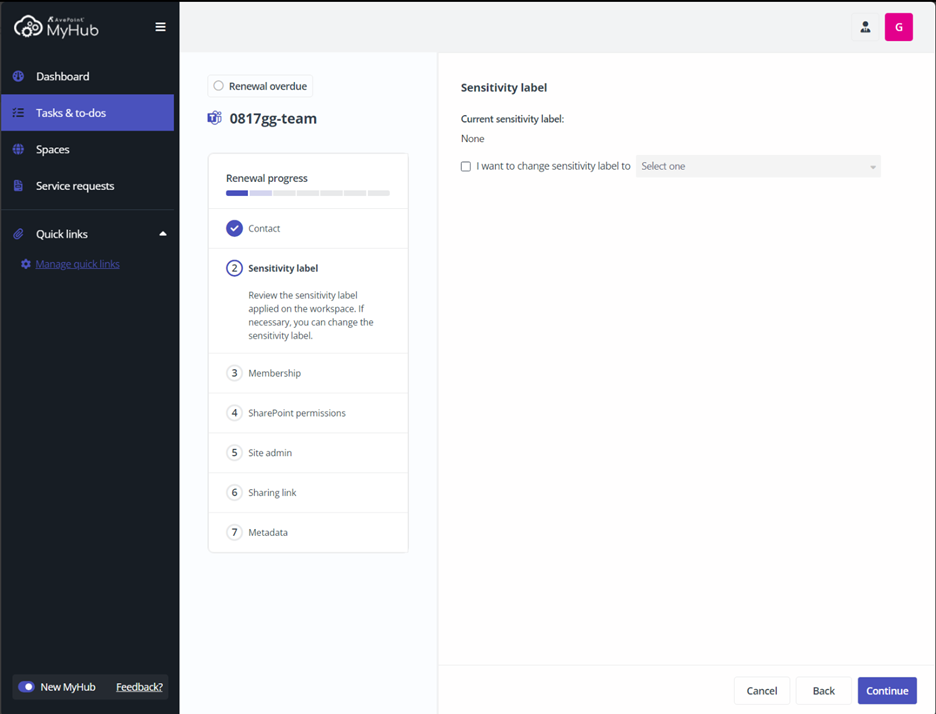
Plus, in this release, we continue to enhance the newly redesigned MyHub, now available in private preview. We've added additional dynamic services and task types to boost productivity and seamlessly integrate additional AvePoint capabilities.
AvePoint Fly
What's new in Fly?
Aviator's new file-level access for Teams and Groups makes it even easier to manage your content. Our newest features enhance your ability to navigate and interact with SharePoint sites linked to Teams and Groups, offering detailed navigation down to individual folders and files for a more granular level of control and visibility, making it easier to manage your content. The availability of Custom Public and Private Views allows users to create and save custom views for projects and mappings, with column and filter settings retained even after leaving the page. This allows both team-wide public views and individual private views, enhancing collaboration and personalization.

Delegated App Pooling supports service account pooling through delegated apps, enabling modern authentication with multi-factor authentication and allowing you to manage larger volumes of content within tight timelines for faster and more efficient migrations. Plus, the new aggregated error reporting feature in Report Center allows you to manage and ignore expected or benign errors globally – by tenant, project, or mapping – providing full control to determine the true health of your migration for a smoother, more transparent process.
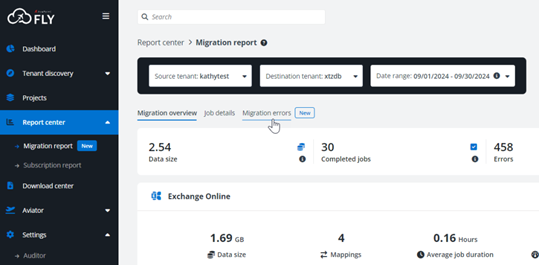
AvePoint EnPower
What's new in AvePoint EnPower?
EnPower's new Power Automate flows status column empowers you to proactively address potential issues before they impact your operations, ensuring smoother and more reliable automated processes with enhanced troubleshooting efficiency and reduced downtime. Dynamic workflows now support additional conditions and actions for Teams activity, sensitivity and classification changes, and expiration, enabling you to automate tasks such as changing sensitivity, removing guest accounts, managing settings, or archiving Teams. The new Channels Report tab under Teams management consolidates all channel information and supports actions such as adding channels, changing channel types, managing membership, and deleting channels, simplifying channel management with a centralized view and control. Additionally, the enhanced governance information for the Microsoft 365 Group module now displays comprehensive governance information within EnPower – including primary and secondary contacts, metadata, phase details, and governance actions such as renewals and contact elections – ensuring that all necessary governance information is easily accessible and manageable.
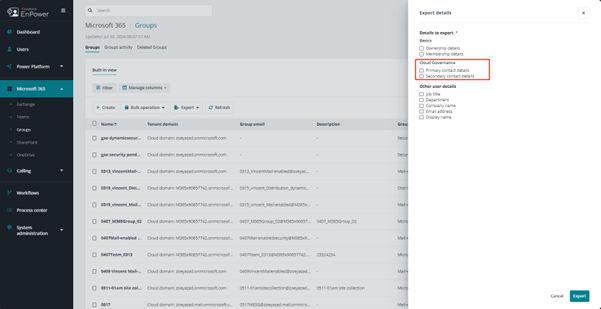
AvePoint Policies for Microsoft 365
What's new in Policies?
Enforce consistent Team naming rules with new settings that ensure all teams within a specific container start with a designated prefix or suffix, adhering to predefined patterns. This update promotes consistent naming conventions across all teams, making it easier to manage and identify teams within your organization. Filter violations by time range in the Violation report to narrow down the scope of discovered violations to recent issues or specific scans. This feature allows you to save views with specific time filters, making it easier to manage and prioritize policy violations.

AvePoint Opus
What's new in AvePoint Opus?
New supported content sources include Box, now available in private preview as a native content source, as we continue to add support for multi-cloud environments. Additionally, cold/archived tiers can be set as retention options and archived data can be permanently deleted after restoration (where an organization is using BYOS). Enhanced search and discovery offers a redesigned full-text search for keyword searches, the ability to restore sensitivity-labeled documents without requiring a system account, and the creation of discovery optimization profiles.
Granular Version Management now offers new version-level rules, enabling you to retain a specified number of versions while archiving the rest, providing more precise control over version management.
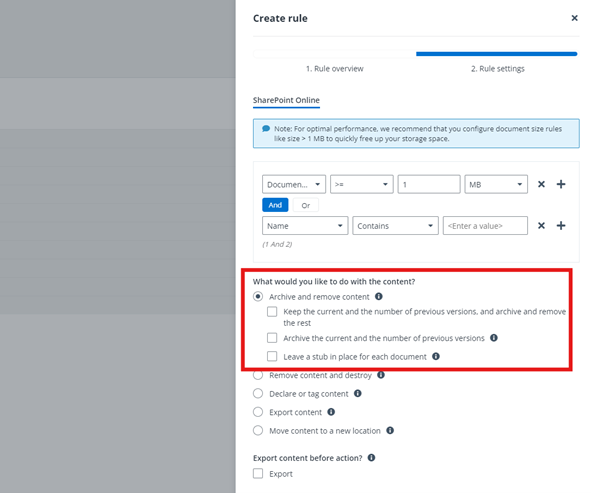
Streamlined physical records management now allows duplicate physical record names if the unique ID is different, and existing barcode information can be imported. This improvement boosts efficiency and eases the transition from legacy systems by resolving record rejection issues during bulk updates due to name duplication. Implementations can be up and running faster with container-level nodes in the import function, ensuring seamless import of files exported at the container level.
You can now exclude specific mailbox items from deletion projects using sensitivity label rules, ensuring that critical information is retained while unnecessary data is efficiently cleaned up. Advanced monitoring and reporting features enable you to filter job activities by specific periods or users, display job settings in reports, and track storage optimization progress by site collection for better oversight, with full visibility into who has run jobs and when. Plus, Opus now offers Korean language support, improving efficiency and adherence to regional data regulations.
AvePoint tyGraph
What's new in AvePoint tyGraph?
New tyGraph benchmarking empowers your organization to elevate adoption by comparing it with industry peers. With this release, opt-in for Copilot adoption benchmarking is now available. Service administrators can activate this feature, ensuring user data remains anonymized while providing valuable insights. This benchmarking capability helps you understand how your organization stacks up against industry standards and identify areas for improvement in new reports coming soon.

The Community Insights report for Viva Engage is now available, offering community owners data on their specific communities. New data centers in France (Paris) and Southeast Asia (Singapore), ensure improved performance and compliance with regional data regulations. Additionally, the ability to customize your views with saved filters, makes it easier to access the data that matters most, saving time by eliminating the need to recreate filters for routine reports. With saved filters, you can streamline your workflow and focus on the insights that drive your business forward, making your Microsoft 365 investment more efficient and impactful.
Learn More About These Updates
Have you signed up for the Account Portal? It’s where you go to access user guides, release notes, how-to videos, free trials, and more! The info you need for this release can be found by simply clicking around the portal. Signing up is easy, and navigating is easier than ever.


